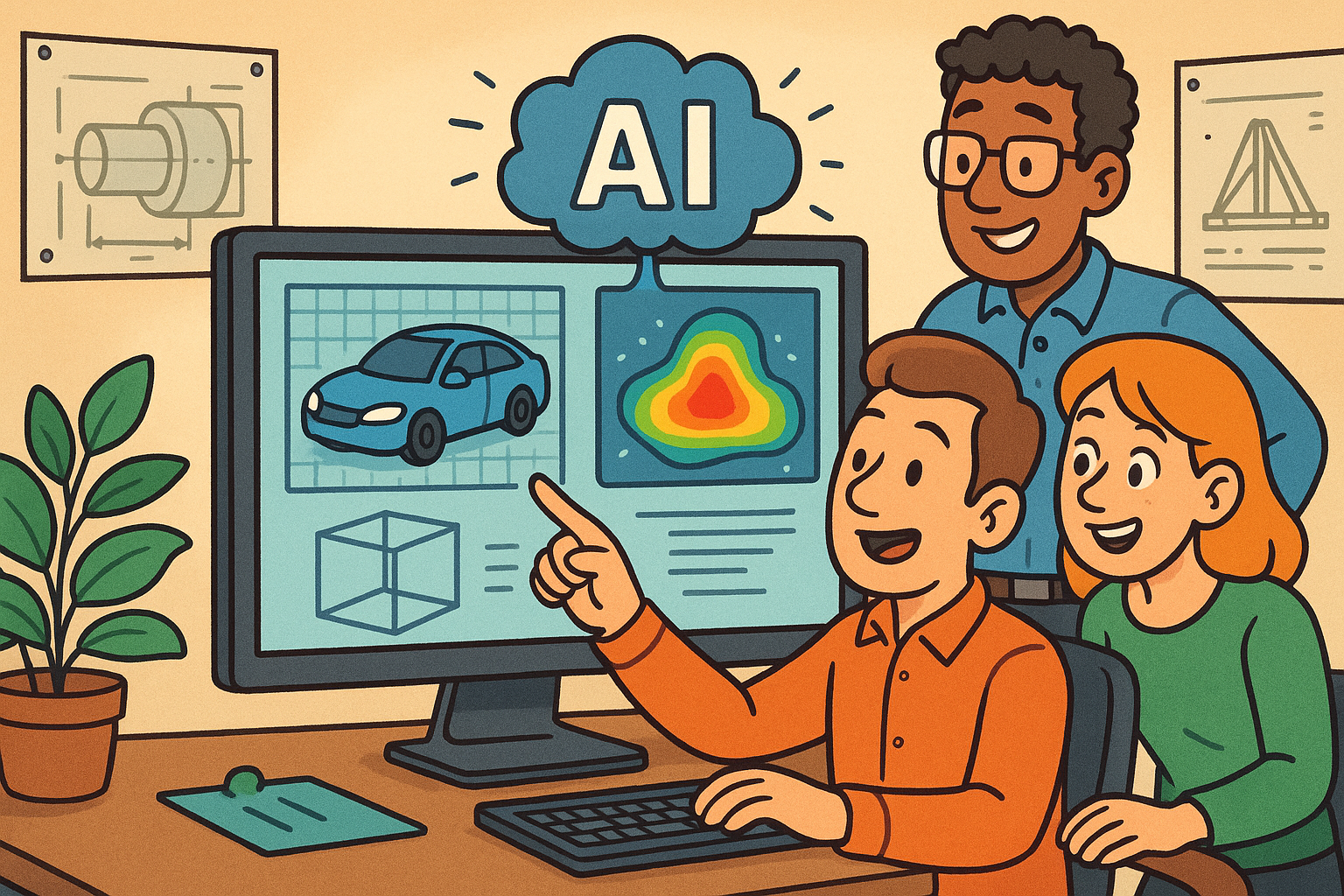Your Cart is Empty
Customer Testimonials
-
"Great customer service. The folks at Novedge were super helpful in navigating a somewhat complicated order including software upgrades and serial numbers in various stages of inactivity. They were friendly and helpful throughout the process.."
Ruben Ruckmark
"Quick & very helpful. We have been using Novedge for years and are very happy with their quick service when we need to make a purchase and excellent support resolving any issues."
Will Woodson
"Scott is the best. He reminds me about subscriptions dates, guides me in the correct direction for updates. He always responds promptly to me. He is literally the reason I continue to work with Novedge and will do so in the future."
Edward Mchugh
"Calvin Lok is “the man”. After my purchase of Sketchup 2021, he called me and provided step-by-step instructions to ease me through difficulties I was having with the setup of my new software."
Mike Borzage
AI-Driven Simulation Tools: Transforming Design and Engineering Practices
August 20, 2025 9 min read


Understanding AI-Driven Simulation Tools
In today’s rapidly evolving design and engineering landscape, AI-driven simulation tools are transforming the way professionals approach the challenge of predicting product performance. These advanced tools integrate artificial intelligence directly into simulation environments, allowing engineers and designers to accurately forecast how their designs will behave under varying conditions. This fusion of AI and simulation creates an ecosystem where traditional computational models are enhanced with machine intelligence, thus enabling the analysis of complex behaviors that were once too difficult or time-consuming to simulate. Such intelligent systems not only improve the precision of simulations but also significantly reduce the time and resources required for iterative testing and prototyping. By incorporating a diverse array of data inputs—from historical performance data to real-time sensor readings—these simulation tools empower design engineers to make data-informed decisions early in the development process.
Defining AI-Driven Simulation and its Role
At the core, AI-driven simulation refers to simulation frameworks where machine learning algorithms and data analytics are integrated within the simulation environment to predict and optimize system behaviors. In modern design software, AI-driven simulations enable designers to emulate and examine the performance of products under a myriad of operating conditions. These tools harness pattern recognition, trend analysis, and predictive modeling to accurately forecast potential shortcomings and performance issues well before a physical prototype is constructed. Their use spans across multiple fields such as automotive, aerospace, and consumer products, where precision in predicting the performance of new designs is not just beneficial but essential. Moreover, they seamlessly integrate with other design and engineering applications, forming a network that spans design conception, validation, and iterative optimization.
Integrating Simulation with Design and Engineering Applications
The integration of AI-driven simulation tools with existing design software is a critical aspect that drives innovation in modern product development. Designers and engineers benefit from a tightly coupled ecosystem that allows simulation outputs to directly influence design choices, fostering a feedback loop that continuously refines both the simulation models and the physical prototypes. This synergistic relationship ensures that the insights gathered during simulation are promptly incorporated into design modifications, which in turn improves overall product performance and enhances system reliability. Additionally, this integration supports collaborative workflows across different departments and expert teams, thereby accelerating the design cycle and reducing the margin of error. Key benefits of this approach include the ability to assess a wide range of scenarios, optimize material usage, and predict system behavior under rare or extreme conditions.
Core Technologies Behind AI-Driven Simulations
The advanced capabilities of AI-driven simulations are powered by a combination of cutting-edge technologies that ensure the accuracy and efficiency of the simulation processes. At the heart of these tools are sophisticated machine learning algorithms that excel in recognizing patterns and identifying performance trends. These algorithms operate on large datasets, learning from past behavior to predict future outcomes. Data analytics tools complement this process by handling complex real-time processing tasks, ensuring that the simulation model is constantly updated with the latest operational data. Moreover, the integration of historical performance data with predictive modeling provides another layer of depth, enabling simulations to account for conditions that have been previously observed in real-world applications. This multi-dimensional approach leverages both retrospective and predictive insights to refine simulation quality and reliability.
Machine Learning Algorithms and Their Role
Machine learning plays an indispensable role in modern simulation platforms. The algorithms are designed to process vast amounts of data, learning the inherent patterns and statistical correlations that define product performance trends. When these algorithms are embedded within simulation tools, they enhance the ability to predict anomalies and foresee potential failures. These predictions are derived from both historical data and continuous real-time inputs, creating a model that is both dynamic and self-improving. The resulting simulation not only evaluates current design parameters but also suggests improvements that could preemptively mitigate risks and improve overall performance. The underlying machine learning models are continually refined as more data becomes available, ensuring that the simulation’s accuracy improves over time. Key benefits of these models include:
- Reduced development cycles through accelerated model iterations
- Enhanced predictive capabilities that catch unforeseen design challenges
- Greater operational efficiency by minimizing the need for extensive physical testing
Data Analytics, Real-Time Processing, and Cloud Environments
Another cornerstone of AI-driven simulation tools is the robust data analytics framework that processes and synthesizes real-time information to feed into the simulation models. These analytics frameworks are responsible for aggregating data from multiple sources, including IoT devices, sensor networks, and embedded systems in the design environment. The integration of this real-time data ensures that simulation outputs are not static but rather adaptive to evolving conditions. Additionally, the significant computational power required to run these simulations is often provided by cloud computing infrastructures and high-performance GPUs, which are critical for handling vast data streams and executing complex computations. The use of cloud computing not only scales the processing capability but also provides a flexible and cost-effective platform for simulating various scenarios simultaneously. The combination of these technologies forms a robust backbone that supports the real-time evolution of predictive models, thereby enhancing the fidelity of the simulation results.
Applications and Industry Impact
The adoption of AI-driven simulation tools has had a profound impact across numerous industries, notably in sectors such as automotive, aerospace, and consumer product design. Historically, traditional simulation approaches focused on static models that required extensive manual calibration and iterative testing. However, the introduction of AI-enhanced simulation methodologies has revolutionized product development by offering dynamic, data-driven insights that preempt design challenges and optimize performance metrics. Organizations employing these tools experience dramatic reductions in prototyping costs and time-to-market. By leveraging advanced predictive analytics and comprehensive simulation models, designers can now identify potential flaws and improve product safety, reliability, and efficiency at an early stage. The transformation has also encouraged more agile design processes, fostering environments where continuous improvement and rapid innovation are the norm. The competitive edge provided by these tools lies in their ability to integrate seamlessly into existing design workflows, offering immediate insights that further enhance the precision of the design process.
Comparative Analysis of Traditional and AI-Enhanced Simulation Methods
A detailed comparison between traditional simulation methods and their AI-enhanced counterparts highlights a number of significant advantages. Whereas traditional methods rely heavily on manually programmed rules and static models, AI-driven simulations use adaptive algorithms that learn from historical data and real-world performance metrics. This allows for a significantly more nuanced understanding of system behavior under variable conditions. The **benefits of AI integration** are evident in:
- Dynamic simulation models that update in real time with sensor data and performance feedback
- Improved prediction accuracy through the use of pattern recognition and machine learning
- Enhanced resource management by reducing reliance on extensive physical prototyping
Adoption Challenges and Benefits for Enterprises
While the integration of AI-driven simulation tools brings notable advantages to large-scale enterprises, it also introduces a set of challenges, particularly for smaller organizations with limited resources. The challenges range from the initial investment required for high-performance hardware and cloud infrastructure to the need for skilled personnel who can manage and interpret the simulation outputs. However, once effectively implemented, the benefits far outweigh these initial hurdles. Among the primary advantages are the ability to leverage real-time simulation data to refine product designs, allocate resources more effectively, and significantly reduce production costs. Companies are witnessing an unprecedented improvement in their product development cycles, thanks to the combination of reliable simulation outputs and the speed of AI computations. The adoption of these tools fosters a culture of continuous improvement and technological agility within organizations, making them more competitive in the rapidly evolving global market. In essence, while the transition to AI-enhanced simulation may present initial logistical and financial challenges, the long-term benefits include greater innovation, enhanced design reliability, and a significant competitive edge.
Future Trends and Evolving Capabilities
Looking forward, the next-generation developments in AI-driven simulation tools are poised to further disrupt traditional design and engineering paradigms. As these tools continue to evolve, we are beginning to see the emergence of self-learning simulation platforms that can autonomously refine their predictive models based on accumulated data, essentially reducing the need for significant human intervention. These advancements open up exciting possibilities for integrating simulation processes with other innovative technologies such as additive manufacturing and virtual prototyping techniques. The overall trajectory points toward a future where the balance between human creativity and machine precision is optimally maintained to deliver increasingly advanced design solutions with reduced turnaround times. Furthermore, as these simulation tools become more sophisticated, their underlying capabilities are expected to expand to address ethical considerations, data security challenges, and regulatory impacts—issues that are critical in an era of digital transformation.
Self-Learning Simulation Platforms and Additive Manufacturing
Self-learning simulation platforms represent a significant milestone in the evolution of design software. These platforms not only simulate various scenarios but also intelligently update their own models by incorporating new data harvested from ongoing processes. This continuous improvement cycle means that each simulation session becomes more accurate and reflective of real-world conditions, enhancing the predictive power of the tool over time. When these platforms are integrated with additive manufacturing techniques, designers are afforded a powerful synergy whereby the simulation insights can directly inform the printing process of prototype components. This confluence fosters an environment where rapid iteration cycles are not only possible but also efficient. Key trends supporting this evolution include:
- The use of real-time feedback loops to automatically update simulation parameters
- Sophisticated integration of virtual prototyping techniques with physical additive manufacturing processes
- Enhanced automation in design optimization, reducing dependency on manual adjustments
Data Security, Ethical Considerations, and Regulatory Impacts
As AI-driven simulation platforms become more deeply ingrained in design and manufacturing workflows, issues related to data security and ethical considerations will naturally come to the forefront. Amid the vast amounts of operational data being used to train these models, the importance of ensuring data integrity and maintaining robust security protocols cannot be overstated. Additionally, ethical considerations, such as the transparent use of AI in decision-making and the mitigation of biases in simulation models, are becoming increasingly significant. Regulatory bodies across various industries are beginning to evaluate the implications of these new technologies, leading to a dynamic interplay between innovation and compliance. Organizations adopting these advanced tools need to ensure that:
- Data handling practices meet emerging security standards
- Simulation outputs are interpretable and free from algorithmic bias
- The deployment of these technologies complies with evolving industry regulations
Conclusion
In summary, the advent of AI-driven simulation tools has significantly revolutionized the process of predicting product performance. By integrating machine learning algorithms, advanced data analytics, and high-performance computing frameworks, these tools offer unparalleled precision and speed in the design and prototyping phases. The integration of AI within simulation environments has enabled organizations to drastically reduce prototyping costs, accelerate time-to-market, and optimize product reliability. While the transformation from traditional simulation methods to AI-enhanced approaches presents certain challenges, particularly in terms of initial investment and data security, the long-term benefits are undeniable. Increased efficiency, adaptive self-learning capabilities, and seamless integration with technologies such as additive manufacturing position these tools at the forefront of next-generation design software solutions.
Reflection on Technological Advancements and Implementation Challenges
The drive toward harnessing the full potential of AI in simulation marks a pivotal moment in modern design and engineering. This rapid technological evolution also demands a balanced approach to overcome implementation challenges. Organizations must stay abreast of emerging trends, invest in the necessary infrastructure, and prioritize continuous learning to truly capitalize on these advancements. Despite the hurdles, the benefits of improved product reliable performance, reduced production cycles, and data-driven decision making remain significant. The pursuit of efficiency and innovation is reinforcing the importance of integrating AI with simulation tools in every stage of the design process, ultimately paving the way for more innovative, safer, and sustainable products.
Encouraging Continuous Learning and Integration
As the landscape of design software and simulation continues to evolve, it is imperative for professionals to remain engaged with the latest developments. Staying informed and adaptable will be the key to leveraging these transformative tools effectively. With advances in self-learning simulations and the growing integration of cloud technologies, the future of AI-driven simulation promises even greater efficiency and creative potential. The ongoing dialogue between technological capability and ethical responsibility ensures that the evolution of these simulation tools is both rapid and balanced. For design and engineering professionals, continuing education and proactive adaptation to new trends will not only enhance their workflows but will also ensure that they remain at the cutting edge of innovation. By embracing these changes and integrating advanced simulation technologies into their practices, companies can achieve enhanced outcomes that were once unimaginable.
Also in Design News

Cinema 4D Tip: Matrix-Driven Instancing for High-Performance Scattering
December 20, 2025 2 min read
Read More
V-Ray Tip: V-Ray Anisotropy Techniques for Brushed Metals and Hair
December 20, 2025 2 min read
Read More
Revit Tip: Revit Nested Tagging: Shared Nested Families and Roll-Up Parameters
December 20, 2025 2 min read
Read MoreSubscribe
Sign up to get the latest on sales, new releases and more …


